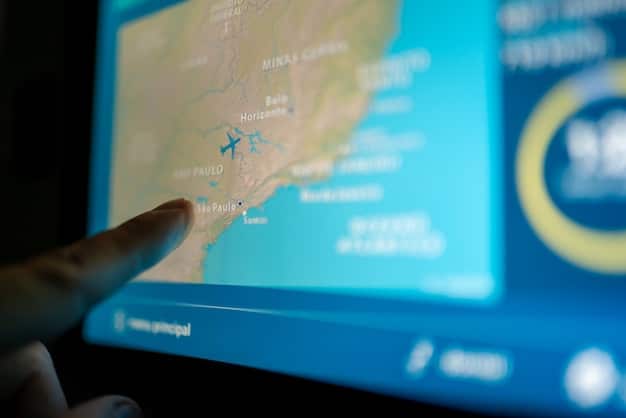US Airlines Frequent Flyer Program Changes 2025: What to Know

Navigating the evolving landscape of airline loyalty programs is crucial for frequent travelers, especially with major US airlines announcing significant changes to their frequent flyer programs taking effect in 2025, which may impact how miles are earned, redeemed, and elite status is achieved.
For many travelers, frequent flyer programs are more than just a perk; they are a cornerstone of their travel planning, offering pathways to discounted flights, upgrades, and exclusive benefits. As we approach 2025, major airlines across the United States are rolling out significant adjustments to these very programs. Understanding the implications of these changes is paramount for maximizing your travel rewards and ensuring your loyalty continues to pay off. We delve into what these new policies entail and how they might reshape your flying experience.
Understanding the Shift in Frequent Flyer Program Philosophy
The landscape of airline loyalty is in constant flux, driven by economic pressures, market competition, and evolving passenger behavior. Historically, frequent flyer programs were designed to reward mileage flown. However, a significant philosophical shift is underway, moving towards revenue-based models that prioritize spending over distance.
This reorientation reflects a broader trend within the travel industry to monetize loyalty more directly. Airlines are increasingly focused on high-value customers who contribute more significantly to their bottom line, rather than those who simply accumulate a large number of miles through lower-cost travel.
The move to revenue-based earning
Many airlines are transitioning to systems where the number of points or miles you earn is directly tied to the amount of money you spend on tickets, rather than the distance you fly. This means a cheaper, long-haul flight might earn fewer rewards than a more expensive, shorter one.
- Increased focus on premium travel: First-class and business-class tickets will yield substantially more rewards.
- Impact on budget travelers: Those who seek out the lowest fares may find their earning potential diminished.
- Devaluation concerns: While not a direct devaluation, the earning threshold for significant rewards becomes higher.
This shift compels travelers to re-evaluate how they choose their flights and which airline loyalty programs align best with their spending habits. It’s no longer just about the destination; it’s about the journey’s cost influencing your future rewards.
Elevated elite status qualifications
Achieving elite status—with its coveted perks like complimentary upgrades, lounge access, and dedicated customer service lines—is becoming more challenging. Airlines are adjusting qualification requirements, often combining spending thresholds with segments flown or miles earned.
This elevation in status requirements is a strategic move to differentiate the most valuable customers. While it creates a more exclusive club, it also means that casual or occasional travelers will find it significantly harder to reach even the lowest tiers of elite status. The perceived value of these benefits, for those who qualify, is likely to increase.
The philosophical underpinning of these changes is clear: a stronger emphasis on profitability and a move away from pure volume-based loyalty. Airlines are striving to create a more direct correlation between customer value and the rewards they receive. This necessitates a proactive approach from travelers to understand and adapt to these new rules of engagement.
American Airlines: Navigating AAdvantage Updates
American Airlines has historically boasted one of the most popular frequent flyer programs, AAdvantage, known for its extensive global network and various earning opportunities. Entering 2025, American is implementing changes that focus primarily on the earning of Loyalty Points, which are the sole metric for achieving AAdvantage elite status.
The goal is to simplify the elite status qualification process by consolidating spending across flights, co-branded credit cards, and eligible partners into a single measure. While this offers transparency, it also means a heightened emphasis on how and where you spend with American and its affiliated partners.
Emphasis on loyalty points earning
The core of American’s changes revolves around Loyalty Points. Every dollar spent on eligible American Airlines and Oneworld flights, as well as on various non-airline partners (like AAdvantage dining or shopping portals), contributes directly to your Loyalty Point balance.
Crucially, purchases made with AAdvantage co-branded credit cards will also earn Loyalty Points. This synergy between flight activity and credit card spending is a significant factor in reaching status tiers.
- Direct correlation with spending: More spending means more Loyalty Points, accelerating status qualification.
- Co-branded credit cards become vital: High spenders on American’s credit cards can earn status without extensive flying.
- Partner activity matters: Engaging with AAdvantage dining, shopping, and car rental partners also contributes.
This streamlined approach means travelers must be strategic about their spending. For those aiming for elite status, consolidating purchases with American Airlines and understanding the Loyalty Point earning rates across various channels will be key.

Impact on award availability and redemption
While the focus is on status earning, there are also subtle shifts in how award miles can be redeemed. American has been moving towards dynamic pricing for award flights, meaning the number of miles required for a given flight can fluctuate based on demand, route, and time of booking.
This can lead to more volatility in award valuations, making it harder to predict the exact number of miles needed for a trip. Travelers should increasingly look for “Web Special” awards, which offer potentially lower mileage rates but come with less flexibility.
For those holding significant AAdvantage miles, proactive planning and flexibility will be essential. The best value for redemptions may now be found by booking further in advance or by being open to off-peak travel times. Understanding these redemption nuances is critical to ensure your accumulated miles continue to offer substantial value.
In essence, American Airlines’ 2025 updates signal a deepening commitment to a revenue-based model for status and a more dynamic approach to awards, urging members to align their spending habits with the AAdvantage ecosystem.
Delta Air Lines: SkyMiles Program Enhancements for 2025
Delta SkyMiles has long been a program known for its robust premium cabin experience and a vast global network through SkyTeam partners. For 2025, Delta is reinforcing its focus on its Medallion Qualification Dollars (MQDs) as the primary determinant for elite status, streamlining the path but also raising the bar for some.
These changes reflect Delta’s strategy to reward its most profitable customers more generously, ensuring that those who contribute significantly to the airline’s revenue receive the highest tier benefits. While this simplifies the qualification metrics, it inherently makes achieving higher tiers more challenging for those with lower-cost travel patterns.
Streamlined medallion status qualification
Delta is consolidating its Medallion Qualification Miles (MQMs) and Medallion Qualification Segments (MQSs) into a single metric: Medallion Qualification Dollars (MQDs). This means elite status will be solely determined by the amount of eligible spending with Delta, Delta Vacations, and Delta co-branded credit cards.
This simplification aims to make the elite status path clearer for travelers. However, it places a direct emphasis on revenue generation, signaling that the most loyal and valuable customers are those who contribute the most financially.
- MQDs as the sole metric: All earnings contribute to a single, easily trackable dollar amount for status.
- Credit card spending boosts: Specific spending thresholds on Delta co-branded Amex cards can waive or contribute directly to MQDs.
- Premium cabin advantage: Higher-priced tickets will naturally accelerate MQD accumulation.
This shift requires SkyMiles members to recalibrate their understanding of status qualification. The days of simply flying many cheap short-haul segments to earn status are largely over; now, it’s about the dollar value of your travel with Delta.
Changes to complimentary upgrades and lounge access
With the intensified focus on MQDs, Delta is also making adjustments to how some of its most prized elite benefits are distributed. Complimentary upgrades, a highly sought-after perk, will likely see increased competition at lower elite tiers as more members concentrate their efforts on MQD attainment.
Lounge access for certain Medallion tiers, particularly the higher ones, remains a core offering. However, there might be subtle adjustments to guest policies or the number of complimentary visits, to manage demand and ensure a premium experience for its top-tier members.
These adjustments are designed to maintain the exclusivity and value of elite benefits for those who earn them at the highest levels. For many, the ability to receive complimentary upgrades and enjoy lounge amenities is a significant driver of loyalty, and Delta is ensuring these remain aspirational perks.
Delta’s 2025 SkyMiles enhancements represent a clear commitment to fostering loyalty based on revenue, pushing members to consolidate their spending within the Delta ecosystem to unlock the most valuable benefits.
United Airlines: MileagePlus Revisions for the New Year
United Airlines’ MileagePlus program has traditionally offered a comprehensive suite of benefits, catering to both business and leisure travelers with its Star Alliance network. For 2025, United is refining its Premier status qualification process, reinforcing its emphasis on Premier Qualifying Points (PQPs) while also clarifying redemption options.
These adjustments are part of a broader industry trend to reward higher-spending customers. United aims to ensure that its most frequent and profitable flyers receive the best advantages, while also trying to maintain clarity in how status is earned and miles are redeemed.
Updated premier status requirements
United’s Premier status qualification will continue to heavily rely on Premier Qualifying Points (PQPs). PQPs are earned based on the dollar amount spent on flights operated by United and United Express, as well as on partner airlines’ flights when booked through United.
While Premier Qualifying Flights (PQFs) still play a role, PQPs are increasingly the dominant factor. This means travelers should focus on spending more with United or its key partners to accelerate their path to elite status.
- PQT and PQF balance: Higher PQPs can sometimes reduce the need for an extensive number of PQFs for higher tiers.
- Premium cabin advantage: Booking higher fare classes or premium cabins directly translates to more PQPs.
- Credit card contributions: Select Chase United co-branded credit cards can offer PQP earnings or waivers.
This re-emphasis on PQPs means that the cost of your ticket directly impacts your status accumulation. MileagePlus members need to strategize their booking choices to align with these new, updated requirements.

Redemption value and mile expiration policies
United has largely moved to dynamic pricing for award flights, similar to other major carriers. This means that the number of miles required for a free flight can change frequently, impacted by demand, route popularity, and booking timing.
To maximize value, members are encouraged to be flexible with their travel dates and destinations. While mile expiration policies have become more lenient across the industry, it’s always prudent to be aware of any inactivity clauses that could lead to forfeiture of miles.
United’s approach to redemption emphasizes flexibility for the airline, requiring a more proactive and adaptable strategy from members. Finding the best redemption value often means searching across various dates and being open to slightly different travel plans.
Overall, United’s 2025 MileagePlus revisions underscore the trend towards a spending-centric loyalty model for status, while maintaining a dynamic and responsive approach to award redemptions.
Southwest Airlines: Rapid Rewards Adjustments
Southwest Airlines’ Rapid Rewards program stands apart from its counterparts by being intrinsically revenue-based. Points are earned directly proportional to the fare paid, and redemption values are generally tied to the cash price of a ticket. Entering 2025, Southwest is fine-tuning elements of its program, particularly around Companion Pass qualifications and tier benefits.
Southwest’s model simplifies the earning and redemption process, making it straightforward for members to understand the value of their points. The upcoming adjustments are aimed at optimizing the program’s most popular features while maintaining its core appeal of simplicity and transparency.
Earning points and companion pass qualifications
Rapid Rewards points are earned based on the fare type purchased. Business Select fares earn the most points per dollar, followed by Anytime and then Wanna Get Away fares. This straightforward earning structure makes it easy for members to calculate their potential earnings.
The highly coveted Companion Pass, which allows a designated person to fly with the member for free (plus taxes and fees) on purchased and award flights, remains a cornerstone of the program. Qualification requires earning a set number of points within a calendar year.
- Fare type matters: Higher-tier fares yield more points per dollar spent.
- Co-branded credit card strategy: Points earned through Southwest co-branded credit cards count towards Companion Pass qualification, offering a significant pathway.
- Shopping and dining portals: Utilizing these partners also contributes to point accumulation for the pass.
For those aspiring to the Companion Pass, a combined strategy of flying and strategic credit card spending often proves most effective. The 2025 adjustments may fine-tune the exact point thresholds, making it crucial for members to stay updated.
Tier benefits and redemption clarity
Southwest offers A-List and A-List Preferred status tiers, providing benefits such as priority boarding, free same-day flight changes, and dedicated check-in lines. While the core benefits are likely to remain, there might be subtle enhancements or clarifications regarding their application.
Redeeming Rapid Rewards points is simple: the value of a point is generally fixed, meaning more expensive flights require more points, but you know exactly what you’re getting. This transparent redemption model removes the guesswork often associated with dynamic award charts.
Southwest’s model aims to keep things predictable. While minor tweaks to benefit specifics or Companion Pass thresholds are possible, the program’s fundamental revenue-based earning and transparent redemption are expected to continue, appealing to travelers who value straightforwardness.
Southwest’s 2025 adjustments are anticipated to maintain the simplicity and transparency that defines Rapid Rewards, with any changes likely focusing on refining existing benefits and potentially adjusting Companion Pass benchmarks to align with current market dynamics.
Alaska Airlines: Mileage Plan Evolutions for 2025
Alaska Airlines’ Mileage Plan has long been lauded for its generous earning rates, particularly with partner airlines, and reasonable redemption values. As 2025 approaches, Alaska is making adjustments that seek to balance rewarding its loyal flyers with evolving industry standards, particularly concerning elite status qualification and partner earning.
Alaska’s strategic alliances, especially with American Airlines within the Oneworld alliance, allow its members extensive global reach. The program updates are designed to ensure consistency across its network while reinforcing the value proposition for its most dedicated members.
Elite qualification and partner earning updates
Mileage Plan’s elite status (MVP, MVP Gold, MVP Gold 75K, and MVP Gold 100K) has traditionally relied on a combination of elite qualifying miles (EQMs) or segments (EQSs) and earning minimums with Alaska flights. For 2025, there may be refinements to these thresholds and an increased emphasis on elite qualifying dollars (EQDs).
Earning miles with partner airlines remains a significant strength of Mileage Plan. However, the earning rates for certain partners or specific fare classes might be adjusted to align more closely with revenue contributions. This means careful review of partner earning charts will be necessary.
- EQD importance: A greater focus on the revenue component, aligning with industry trends.
- Partner earning tiers: Potential differentiation in earning rates based on fare class and partner routing.
- Co-branded credit card impact: Continued utility of credit cards for spending and potential status boosts.
These changes require members to be more attentive to the details of their bookings, especially when flying with partners, to ensure they maximize their elite status qualification and mileage earning.
Award chart adjustments and redemption opportunities
Alaska Airlines has often been praised for its fixed-price award charts, which historically offered predictable and often lucrative redemption opportunities for flights, particularly on premium cabins with its partner airlines. For 2025, there might be subtle adjustments to these charts to reflect competitive market dynamics.
While the goal is to maintain the strong value proposition, some routes or partner redemptions might see slightly increased mileage requirements. Flexibility in travel dates and destinations will continue to be a key strategy for securing the best award flights.
Despite potential changes, Mileage Plan is expected to retain its competitive edge for award redemptions, especially for those who can leverage its diverse partner network. Remaining informed about any new award zones or pricing structures will be beneficial.
Alaska Airlines’ 2025 Mileage Plan evolutions are set to refine the elite status qualification and partner earning landscape, while still aiming to provide strong redemption value, requiring members to stay informed to optimize their benefits.
Strategic Tips for Frequent Flyers in 2025
As US airlines continue to evolve their frequent flyer programs, staying ahead requires a proactive and informed strategy. The shift towards revenue-based models and higher elite status thresholds means that casual accumulation of miles may no longer be sufficient to yield significant benefits. Travelers must become more strategic about their choices, from which airline they fly to which credit card they use.
Maximizing value in 2025 will involve a blend of careful planning, understanding program nuances, and leveraging various earning opportunities. The goal is to ensure your loyalty is truly rewarded and that your travel experience remains as seamless and beneficial as possible.
Consolidate spending and optimize credit card use
With the intensified focus on revenue-based earning for both miles and elite status, consolidating your spending with one or two preferred airlines (or their alliances) becomes extremely important. This means booking flights, hotels, and car rentals through your chosen airline’s portals or partners whenever possible.
Furthermore, airline co-branded credit cards are no longer just for earning miles on purchases; they are increasingly crucial for accelerating elite status. Many cards now offer direct earning of elite qualifying points/dollars based on spending, or provide waivers that can significantly lower status thresholds.
- Pick one or two primary airlines: Focus your loyalty to maximize status potential.
- Utilize co-branded credit cards strategically: Meet spending bonuses and elite status thresholds through card use.
- Leverage shopping and dining portals: Earn extra miles/points on everyday purchases.
This integrated approach to spending ensures that every dollar contributes to your overall loyalty program benefits, whether it’s for earning miles for flights or for achieving valuable elite status.
Monitor program changes and diversify strategies
Airline programs are dynamic, and changes can occur with little notice. It’s crucial to actively monitor official airline announcements, subscribe to loyalty program newsletters, and follow reputable travel blogs that cover frequent flyer news.
While focusing on one or two primary programs is advised, it’s also wise to diversify your strategies to some extent. This might involve holding a general travel rewards credit card (like Chase Ultimate Rewards or Amex Membership Rewards) that offers flexibility to transfer points to various airline partners, providing a hedge against program devaluations.
Staying informed allows you to adapt quickly to new rules, redeem miles before unfavorable changes take effect, or adjust your spending habits to meet new qualification criteria. A well-informed traveler is a well-rewarded traveler.
The landscape of frequent flyer programs in 2025 demands a more sophisticated approach. By strategically consolidating spending, optimizing credit card usage, and staying vigilant about program updates, travelers can navigate these changes effectively and continue to unlock significant value from their airline loyalty.
| Key Change | Brief Description |
|---|---|
| 💲 Revenue-Based Earning | Points/status earning increasingly tied to dollars spent, not miles flown. |
| 🏆 Higher Elite Status Bars | New thresholds and combined metrics make elite qualification more challenging. |
| 💳 Credit Card Synergy | Co-branded credit card spending significantly impacts status and earning. |
| 🔄 Dynamic Award Pricing | Mileage redemption costs vary based on demand and other real-time factors. |
Frequently Asked Questions about 2025 Frequent Flyer Changes
▼
Airlines are adjusting their programs to enhance profitability and better recognize their most valuable customers. The shift primarily involves moving towards revenue-based models, where earning miles and achieving elite status is more directly tied to how much money a passenger spends with the airline and its partners, rather than just the distance flown.
▼
For most airlines, achieving elite status will become more challenging for those who primarily seek the lowest fares. The new models emphasize spending thresholds (like Medallion Qualification Dollars or Premier Qualifying Points) over traditional metrics. This means you might need to spend more money or strategically use co-branded credit cards to reach the same status tier.
▼
While existing miles typically don’t expire for active members (as long as you have activity in your account), the value of redemptions might change. Many airlines are moving to dynamic pricing for award flights, meaning the number of miles required for a ticket can fluctuate based on demand. This isn’t a direct devaluation, but it can make it harder to find high-value redemptions.
▼
Co-branded credit cards are becoming increasingly vital. Many airlines allow spending on these cards to count directly towards elite status qualification (e.g., earning MQDs or PQPs from credit card spend) or to provide waivers that lower the spending requirement. Using these cards strategically could significantly accelerate your path to elite status without extensive flying.
▼
The most important action is to consolidate your loyalty. Choose one or two primary airlines and focus your flying, spending, and credit card usage within their ecosystems. Understanding the specific changes to your chosen program and aligning your travel habits accordingly will be key to maximizing your benefits in 2025 and beyond.
Conclusion
The changes sweeping through US airline frequent flyer programs for 2025 are more than mere tweaks; they represent a fundamental realignment of how airlines value and reward their most loyal customers. The overarching theme is a strong shift towards revenue-based models, where the money spent carries more weight than the miles flown. This paradigm shift necessitates a more strategic approach from travelers, encouraging consolidation of spending, judicious use of co-branded credit cards, and continuous monitoring of program updates.
While these adjustments might initially seem daunting, they also present an opportunity for informed travelers to optimize their strategies. By understanding the nuances of each program—be it American’s Loyalty Points, Delta’s MQDs, United’s PQPs, or Southwest’s Companion Pass qualifications—frequent flyers can continue to unlock significant value from their loyalty. The future of frequent flyer programs demands adaptability, but the rewards for those who navigate these changes wisely remain substantial, ensuring that dedicated travelers continue to enjoy enhanced experiences in the skies.





